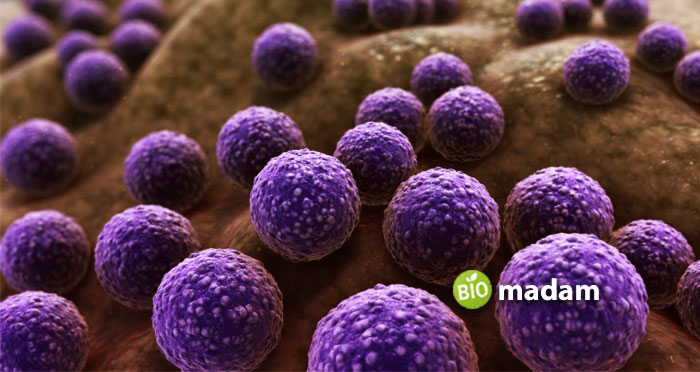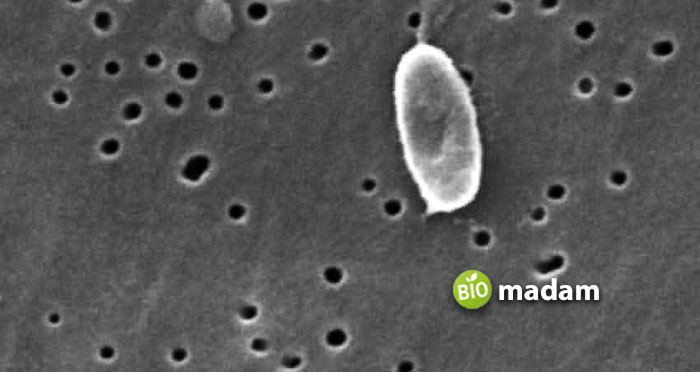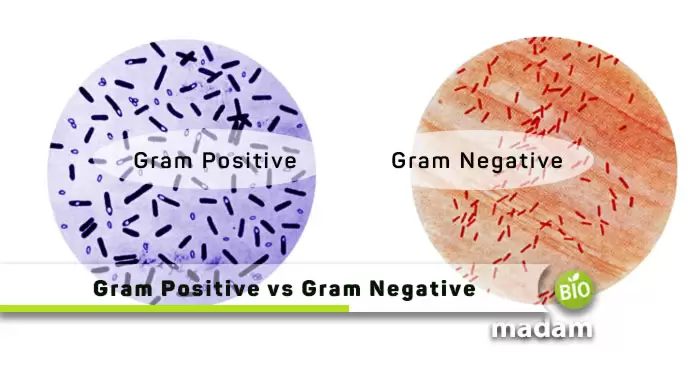Our biome and ecosystem comprises various kinds of organisms and microorganisms including bacteria. They are divided into gram-negative and gram-positive bacteria according to their cell wall composition. The stain retention is the most fundamental difference between gram-positive and gram-negative bacteria. Both bacteria produce specific diseases and infections in organisms.
Let’s tell you everything about gram-positive and gram-negative bacteria.
Comparison Table
| Characteristics | Gram-Positive Bacteria | Gram-Negative Bacteria |
| Staining | Violet | Pink |
| Cell Wall | Single layered | Double layered |
| Texture of Cell Wall | Smooth | Wavy |
| Thickness of Cell Wall | 20 – 80 nm | 8 – 10 nm |
| Outer Membrane | Absent | Present |
| Peptidoglycan | Thick layer | Thin layer |
| Teichoic Acid | Present | Absent |
| Lipid Content | Low | High |
| Periplasm | Absent | Present |
| Porins Channel | Absent | Present |
| Flagella Structure | Two basal body rings | Four basal body rings |
| Toxins | Exotoxins | Endotoxins & exotoxins |
| Drying Resistance | High | Low |
| Antibiotic Resistance | Low | High |
| Examples | Staphylococci, Pneumococci, & Streptococci | E. coli, Klebsiella, & Pseudomonas aeruginosa |
What are Gram-Positive Bacteria?
Gram-positive bacteria give a “positive” result when stained with crystal violet dye. They retain the crystal violet stain of ethanol and iodine when introduced to the bacterial cells. The reason for taking the color of the dye is a slight change in their cell wall compared to gram-negative.
Their cell wall has a thick structure with many peptidoglycans, phosphate, and teichoic acid layers. Two types of teichoic acids are found in the cell wall of these bacteria; teichoic wall acid and lipoteichoic acid. It allows the gram-positive bacteria to retain the color of the dye.

Characteristics of Gram-Positive Bacteria
- Gram-positive bacteria lack an outer cell membrane but have a cell wall.
- They have lower lipid content than gram-negative.
- Gram-positive bacteria contain more teichoic acids.
- The lipid membrane in the cytoplasm of a gram-positive bacteria is thick with a peptidoglycan layer.
- They use cilia and flagella for locomotion.
Risks Associated with Gram-Positive Bacteria
Most mucosal and skin infections are caused by gram-positive bacteria. They are also associated with the risk of respiratory diseases, dental infections, food poisoning, etc. Gram-positive bacteria can be transmitted through direct contact, inhalation and skin.
Diseases Caused by Gram-Positive Bacteria
- Tuberculosis
- Pneumonia
- Diphtheria
- Cavities
- Cellulitis
- Scarlet fever
Examples of Gram-Positive Bacteria
The most common examples of gram-positive bacteria include staphylococci, pneumococci, streptococci, Corynebacterium diphtheria, and Bacillus anthracis.
What are Gram-Negative Bacteria?
Gram-negative bacteria get their name from the inability to absorb the violet color of the stain. However, it does not mean they do not take up any color, instead, they retain the hue of the red dye used as counterstain.
The absorbance of the color is dependent on the composition of the cell wall, which is thin as compared to gram-positive bacteria. Lipoproteins in the cell wall have peptidoglycans attached to them. The periplasm between the layers contains degrading enzymes and proteins.
The chemical used to stain gram-negative cell walls is Safranin, often known as the counterstain. It can be washed with alcohol to remove the color. You can observe gram-negative bacteria in a slight pink color under the microscope.

Characteristics of Gram-Negative Bacteria
- Gram-negative bacteria have a high amount of lipids.
- They contain less muramic acid than gram-positive.
- Gram-negative bacteria do not have teichoic acids and magnesium ribonuclease.
- They have sialic acid to help in spreading pathogenicity.
Risks Associated with Gram-Negative Bacteria
Gram-negative bacteria majorly contribute to gastrointestinal and kidney diseases. They cause infection in the small and large intestines, stomach, and kidneys.
Diseases Caused by Gram-Negative Bacteria
- Diarrhea
- Kidney damage
- Cholera
- Typhoid
- Wounds
- Meningitis & Encephalitis
Examples of Gram-Negative Bacteria
Examples of gram-negative bacteria include E. coli, Klebsiella, and Pseudomonas aeruginosa.
Similarities between Gram-Positive and Gram-Negative Bacteria
- Gram-positive and gram-negative bacteria cause infections and diseases.
- They can be stained using particular dyes to be observed under the microscope
- They both contain peptidoglycan in their composition.
- Both kinds of bacteria contain flagella for locomotion.
Difference between Gram-Positive and Gram-Negative Bacteria
Definition
Gram-Positive Bacteria
Gram-positive bacteria are the one that obtain a specific color through staining.
Gram-Negative Bacteria
Whereas, gram-negative bacteria obtain their color through counterstaining.
Cell Wall Structure
Gram-Positive Bacteria
Gram-positive bacteria have a smooth, single-layered cell wall. The thickness of the gram-positive bacterial cell wall is between 20 to 80 nanometers.
Gram-Negative Bacteria
In comparison, gram-negative bacteria have a wavy, double-membrane cell wall with an outer layer. It has a thickness of 8 to 10 nanometers.
Staining
Gram-Positive Bacteria
They obtain a beautiful crystal violet color on staining.
Gram-Negative Bacteria
On the other hand, you observe a pinkish hue on gram-negative bacteria on staining with a counterstain.
Peptidoglycan
Gram-Positive Bacteria
They have a thick peptidoglycan layer made of multiple stacked layers.
Gram-Negative Bacteria
Alternatively, the peptidoglycan layer in gram-negative bacteria is thin compared to gram-positive bacteria.
Teichoic Acids
Gram-Positive Bacteria
Gram-positive bacteria cell walls have teichoic acids, including lipoteichoic and teichoic wall acid.
Gram-Negative Bacteria
Conversely, gram-negative bacterial cell walls do not have teichoic acids.
Lipid Content
Gram-Positive Bacteria
The lipid content in gram-positive cell walls is very low to absent.
Gram-Negative Bacteria
Although gram-negative bacteria have a high lipid content in their cell wall.
Periplasm
Gram-Positive Bacteria
Gram-positive bacteria do not have periplasm due to the absence of an outer wall.
Gram-Negative Bacteria
At the same time, gram-negative bacteria contain periplasm between the layers.
Porins Channel
Gram-Positive Bacteria
Gram-positive bacteria do not have porins and transport takes place across the cell wall through integral proteins.
Gram-Negative Bacteria
Gram-negative bacteria contain porins in the cell wall that help in the exchange of nutrients and pathogenesis.
Flagella Structure
Gram-Positive Bacteria
The flagella structure contains two rings in the basal body in such organisms.
Gram-Negative Bacteria
Gram-negative bacteria have four rings in their basal body.
Toxins
Gram-Positive Bacteria
Gram-positive bacteria produce exotoxins.
Gram-Negative Bacteria
On the contrary, gram-negative bacteria produce exotoxins and endotoxins.
Drying Resistance
Gram-Positive Bacteria
Gram-positive bacteria have a high resistance to drying.
Gram-Negative Bacteria
However, gram-negative bacteria are not as resistant to drying as gram-positive.
Antibiotic Resistance

Gram-Positive Bacteria
Gram-positive bacteria are less resistant to antibiotics.
Gram-Negative Bacteria
In contrast, gram-negative bacteria have a higher resistance to antibiotics.
Example
Gram-Positive Bacteria
Examples of gram-positive bacteria include Staphylococci, Pneumococci, Streptococci, etc.
Gram-Negative Bacteria
E. coli, Klebsiella, and Pseudomonas aeruginosa are a few examples of gram-negative bacteria.
The Bottom Line
Gram-positive and gram-negative bacteria are disease-causing pathogens causing various ailments in humans. They obtain unique stains due to the difference in their cell wall composition. Gram-positive bacteria has a single-layered cell wall and obtains purple stain. On the contrary, gram-negative bacteria take up a pink stain and have a double-layered wavy cell wall. Streptococci and E. coli are common examples of gram-positive and gram-negative bacteria respectively.
FAQs
What are the characteristics of gram-positive bacteria?
Gram-positive bacteria have all the structures present in prokaryotic cell. They lack a nucleus and mitochondria and have a thick cell wall made of multiple layers of peptidoglycan. Their cell wall is up to 80 mm in thickness. They do not have an outer layer and retain the crystal violet stain.
What antibiotics cover diseases caused by gram-positive and gram-negative bacteria?
Cloxacillin and penicillin are typically used for gram-positive bacteria, and cephalosporins treat gram-negative organisms. However, penicillin and erythromycin are broad-spectrum antibiotics and are effective against both kinds of bacteria. Still, you should take medicines prescribed by your doctor.
What is the difference between gram-positive and gram-negative bacteria staining?
Gram-positive and gram-negative bacteria have distinct cell walls that take different kinds of stains. Gram-positive ones take up a violet stain while gram-negative ones have a pink stain.
Which is more harmful gram-positive bacteria or gram-negative bacteria?
Gram-negative bacteria are more harmful compared to gram-positive bacteria and are more resistant to antibiotics because of the presence of a slimy outer layer.

Hello, I would like to introduce myself to you! I am Chelsea Rogers, an experienced blog writer for science articles, holding an MPhil degree. My enthusiasm to grab the best knowledge, let it relate to botany, zoology, or any other science branch. Read my articles & let me wait for your words s in the comment section.

